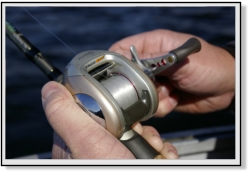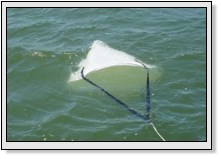|
 “Equipment
101 – Gear Ratios, Thrust, and Drift Socks” “Equipment
101 – Gear Ratios, Thrust, and Drift Socks”
By Justin Hoffman
The more we know and understand about our
fishing equipment, the better prepared we are
when it comes time to rely on it. This insight
also allows us to make informed decisions on
what will make the best fit for purchasing
products.
Here is some advice for getting your head around
reels, motors, and socks.
 Narrowing
Down Gear Ratios Narrowing
Down Gear Ratios
Baitcast reels are designed to provide
either power or speed. Since we face multiple
scenarios throughout a day of fishing,
uncovering the facts on gears can make our life
on the water much easier and more productive.
An example of a gear ratio
is 6.4:1. The last number represents one
complete turn of the reel handle - the first
describes how many times the spool rotates. In
this case, 6.4 spool revolutions for each crank
of the handle. High
gear ratios (7.1:1) are built for speed. Line
can be retrieved quickly and efficiently. A reel
of this style works best for fast presentations,
such as burning spinnerbaits and lipless
crankbaits, or when working areas that require
quick pitches or flips to specific spots, like
docks, cane, or weed clumps.
Low gear ratios (5.4:1) signify power. Effort
and line retrieval is greatly reduced when
reeling, making it a good choice when tossing
high resistance lures, namely deep diving
crankbaits or oversized spinnerbaits. Swimbaits
are another application that can be worked more
effectively with a lower gear ratio reel.
A baitcast reel sporting a ratio of 6.4.1 is
your best bet for reaping the rewards of both
power and speed. It’s the “all purpose” model in
the baitcast world.
A
Matter of Thrust
 Thrust (defn.) - The power rating of an
electric trolling motor that is measured in
pounds. Thrust (defn.) - The power rating of an
electric trolling motor that is measured in
pounds.
A trolling motor is an indispensable piece of
equipment for those serious about fishing.
Choose the wrong “thrust”, however, and you
might as well be treading water.
Here are five simple rules for narrowing down
the correct thrust:
1. You will need a minimum of five-pounds of
thrust for every 350-pounds of load. This latter
figure includes boat, equipment, gas, and
people.
2. A boat measuring 14-foot in length requires
32-pounds of minimum motor thrust under “normal”
fishing situations ; 55-pounds for an 18-foot
craft.
3. Those who fish in adverse conditions – big
water, high winds, heavy vegetation, long hours
– should choose a thrust rating considerably
higher than those recommended.
4. Buy as much power as you can afford, within
reason. Lowering speed/power is always possible
with a high-thrust motor – upgrading power on an
undersized unit is not.
5. Don’t cut corners. A higher thrust motor may
cost more initially, but the extended life (no
need to upgrade) and lack of frustrations are
definitely priceless.
 Drift
Socks – One Size Doesn’t Fit All Drift
Socks – One Size Doesn’t Fit All
A drift sock is a large, oval shaped
“sock” that is lowered over the side of the boat
in order to slow speed, and effectively work
structure areas. A must for walleye anglers and
flat fishermen. But for anyone that abhors the
thought of fishing in the wind, the drift sock
is a definite saviour.
When it comes to choosing a sock, keep in mind
some recommendations for size:
●
Boats to 14 feet – 26”
●
Boats to 16 feet – 30”
●
14 to 18 feet – 38”
●
16 to 22 feet – 44” or 48”
●
18 to 22 feet – 56”
Much like I mentioned with the trolling motors,
it is best to upgrade one sock size to give you
that extra slowing power you may need,
especially if you work the boat in high winds or
areas with strong current.
Another bit of advice is to purchase two drift
socks for the boat. These can be useful when the
wind is really blowing, and with one tied to the
bow and one on the stern, drift control can be
better managed and adjusted.
Choose a sock that is manufactured from
reinforced nylon – it will stand up to the
abuse, and not leave you “stranded” on a
blustery afternoon.
|